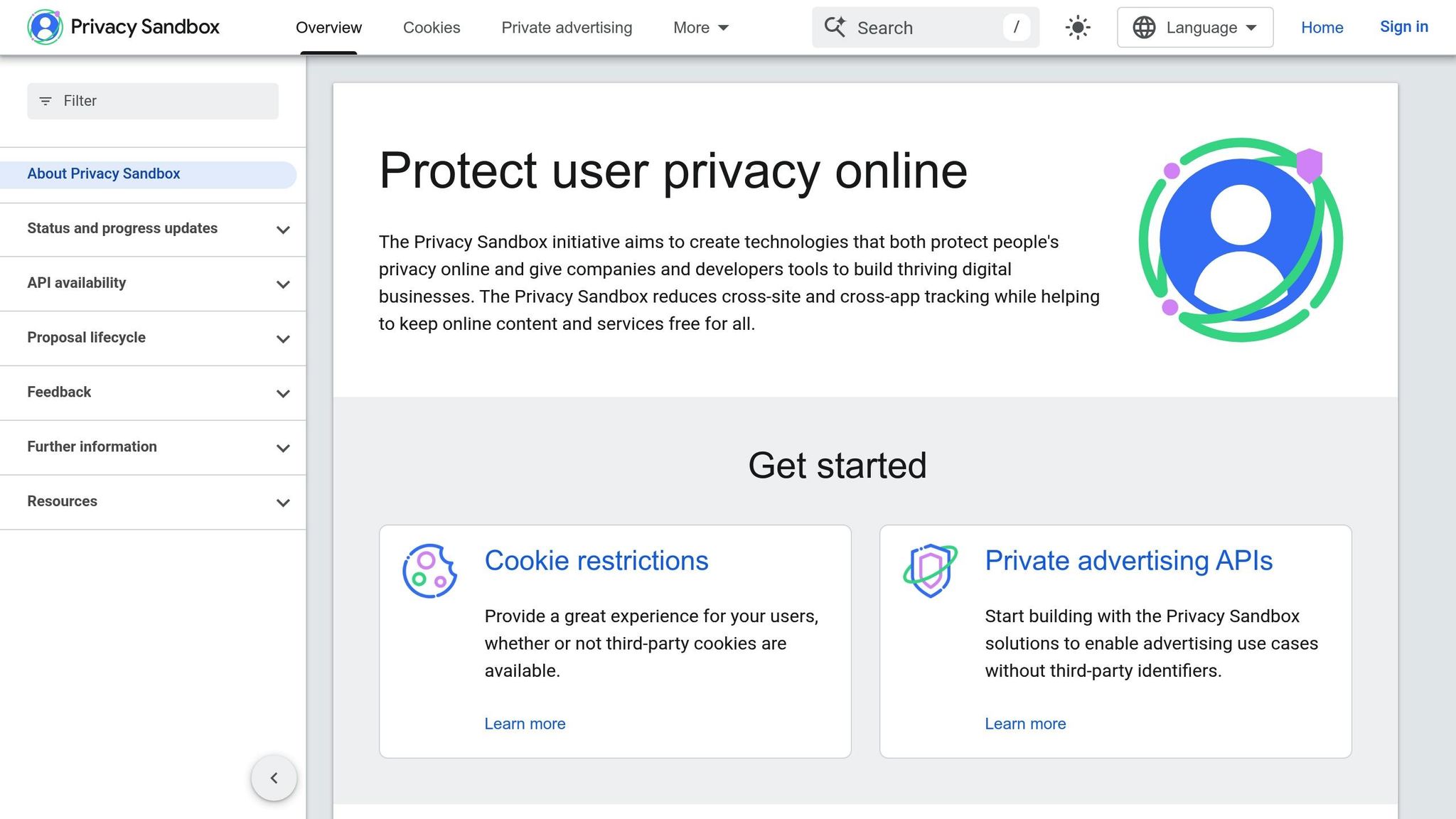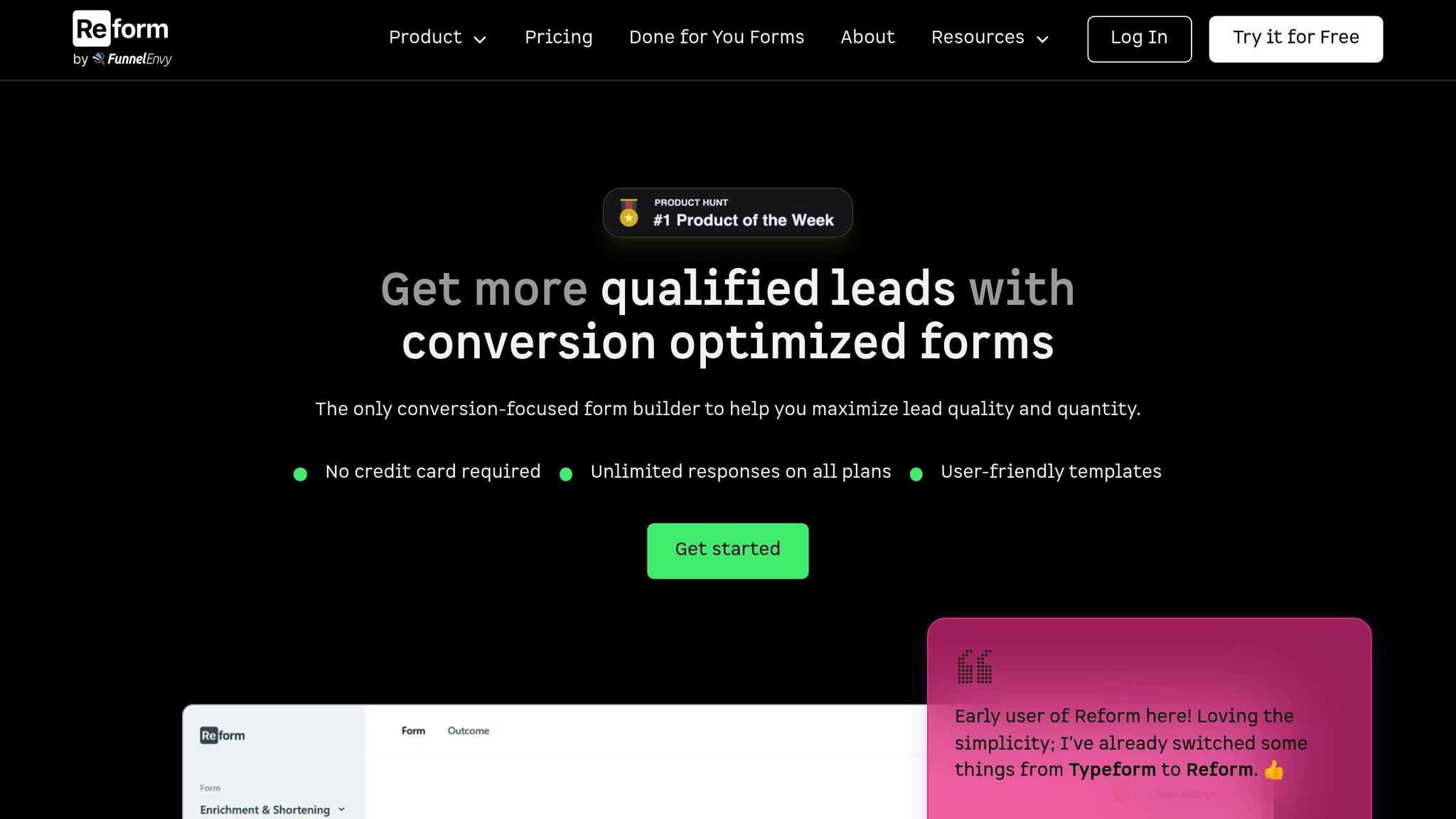Policy Changes Impacting Third-Party Cookies

Third-party cookies are being phased out, and it's changing the way businesses collect and use online data. Here's what you need to know:
- What are third-party cookies? Small files used to track users across sites for targeted ads.
- Why are they being restricted? Rising privacy concerns and regulations like GDPR and CCPA demand more transparency and user control.
- Who's leading the change? Apple’s Safari and Mozilla’s Firefox already block third-party cookies. Google Chrome, with 63% of global browser traffic, will phase them out by late 2024, replacing them with Privacy Sandbox tools.
- Impact on businesses: 69% of advertisers say this shift will hurt more than privacy laws. Retargeting and ad personalization are becoming less effective, raising costs and reducing revenue.
- Solutions: Businesses must focus on first-party data collection, adopt privacy-first advertising tools like Google's Topics API, and use platforms like Reform to collect data directly and comply with regulations.
The end of third-party cookies is forcing businesses to rethink how they connect with users. Companies that prioritize privacy, transparency, and first-party data will be better prepared for the future.
Privacy Sandbox: Preparing for the end of 3rd-party cookies

Recent Policy Updates and What They Mean for Businesses
Over the past four years, digital privacy reforms have pushed US businesses into a whirlwind of change. What began as isolated tweaks to browser policies has snowballed into a sweeping industry-wide transformation, reshaping how companies gather and use customer data.
The impact is already showing. A whopping 69% of advertisers say the deprecation of third-party cookies will hit their business harder than privacy laws like GDPR and CCPA. Yet, only 46% feel ready for the challenge. This gap is especially troubling when you consider that a 2024 global survey found nearly 32% of in-house marketers and 31% of agency marketers still heavily depend on third-party cookies.
For US businesses, these changes go beyond technical tweaks. They signal a fundamental shift in how companies connect with customers, measure the success of their campaigns, and nurture long-term relationships. Smaller businesses, in particular, are feeling the squeeze since they often lack the robust first-party data that larger companies rely on. To understand how we got here, let’s take a closer look at the key events driving this transformation.
Timeline of Major Policy Changes (2020-2024)
The movement toward a cookieless future has been brewing for years, but the pace of change since 2020 has left many businesses scrambling to keep up. Here are some of the pivotal moments:
- January 2020: Google announced its plan to phase out third-party cookies in Chrome. With Chrome commanding 60% of the browser market, this news sent shockwaves through the advertising world. This wasn’t Google’s first step toward privacy, though - the company had introduced its Privacy Sandbox initiative back in August 2019, aiming to balance user privacy with advertising needs.
- January 2024: Chrome began testing cookie restrictions with 1% of its users - roughly 30 million people. These tests highlighted real-world challenges businesses face in adapting to new privacy norms.
- April 2024: The UK’s Competition and Markets Authority (CMA) temporarily halted the rollout of Google’s Privacy Sandbox. This regulatory intervention added more uncertainty to an already complex timeline for businesses trying to plan their digital strategies.
"We continue to move forward with our plans to phase out third-party cookies in H2 2024, subject to addressing any remaining competition concerns from the UK CMA. We are confident the industry can make the transition in 2024 based on all the tremendous progress we've seen from leading companies." – Google
How Different Browsers Handle Third-Party Cookies
The way browsers handle third-party cookies has become a patchwork of policies, creating a tricky environment for US businesses. Each browser has its own approach, timeline, and restrictions, making it tough to craft a unified marketing strategy. Here’s a breakdown of the major players:
| Browser | Third-Party Cookie Policy | Implementation Date | Key Features | Market Impact |
|---|---|---|---|---|
| Safari | Blocks all third-party cookies by default | June 2017 | Intelligent Tracking Prevention (ITP) | Set the standard for aggressive privacy policies |
| Firefox | Blocks known tracker cookies by default | 2019 | Enhanced Tracking Protection (ETP) | Balances privacy with usability |
| Chrome | Testing restrictions, full rollout delayed | January 2024 (testing phase) | Privacy Sandbox initiative, user choice emphasis | Affects over 60% of global web traffic |
| Brave | Blocks third-party cookies by default | Default setting | Built-in ad blocking with a privacy-first focus | Attracts a growing base of privacy-conscious users |
These differences create real challenges for businesses. For example, Safari blocks both first- and third-party cookies by default, posing a major hurdle for companies targeting Safari users, who account for a significant chunk of mobile traffic in the US. Meanwhile, Chrome has taken a more gradual approach, likely because its advertising-driven business model requires a careful balance. This slower rollout gives businesses some breathing room but also underscores the massive impact Chrome’s eventual changes will have, given its dominance.
For businesses, this fragmented landscape means more complexity and higher costs. Companies must now tailor strategies for different browsers, test campaigns across multiple platforms, and explore alternative tracking methods. Smaller businesses, in particular, may struggle to keep up due to limited technical resources.
Browsers like Firefox, Safari, and Brave, which block third-party cookies by default, have set a high bar for privacy. Chrome, on the other hand, continues refining its Privacy Sandbox initiative, offering a more gradual transition. As these privacy-focused policies gain momentum, advertisers are increasingly calling for greater transparency and accountability in how their ad budgets are spent. These shifts are forcing businesses to rethink their digital marketing strategies and how they approach customer acquisition in this evolving landscape.
Problems Created by Third-Party Cookie Restrictions
The removal of third-party cookies has shaken the digital marketing world, making long-standing strategies less effective and significantly more expensive. Tools that marketers once relied on now struggle to deliver results, pushing costs higher or, in some cases, failing altogether.
The scale of this disruption is hard to ignore. Despite 75% of marketers globally still depending on third-party cookies, about 40% of browser traffic no longer supports them. This gap is forcing businesses to overhaul their marketing workflows, rethink how they allocate budgets, and redesign their customer acquisition strategies. The ripple effect is being felt in areas like advertising performance and lead generation, where the absence of cookies is creating noticeable challenges.
Impact on Digital Advertising and Lead Generation
Without third-party cookies, the precision of ad targeting has taken a major hit. Marketers can no longer track users across multiple sites to build detailed profiles, making ads feel less relevant and more like random noise. What used to be timely and personalized now often misses the mark.
According to McKinsey, relying solely on first-party data can increase marketing costs by as much as 20% while cutting revenue by up to 50%. Retargeting campaigns, once a cornerstone of digital marketing, have lost much of their effectiveness. Without the ability to track users across platforms, re-engaging past visitors becomes a far more challenging task.
Lead generation processes are also feeling the strain. Tracking a customer’s journey through the marketing funnel has become fragmented. While businesses can still monitor activity on their own websites, they now lack visibility into what users do before or after visiting. This makes it harder to identify which marketing channels are driving high-quality leads. Additionally, without accurate attribution data, marketing teams are left guessing when it comes to budget decisions, relying on less precise methods to measure success.
Compliance and Privacy Hurdles
The shifting privacy landscape has introduced a maze of regulations that businesses are struggling to keep up with. What used to be a straightforward cookie policy has transformed into a complex web of legal requirements, browser-specific rules, and user consent challenges.
Managing consent has become an especially difficult task. A Deloitte study found that 65% of internet users are concerned about how their data is tracked online. This means companies must not only meet legal requirements but also address user concerns about privacy. Ensuring consent is collected and documented across multiple touchpoints has become a major operational burden for many organizations.
Transparency is now a critical expectation. Users want to know exactly what data is being collected, how it’s being used, and who it’s being shared with. However, many businesses lack the internal knowledge or resources to provide these explanations, which undermines trust.
"The biggest roadblock is people not knowing how data is being used or collected. If they're more informed, they feel more in control, making marketing efforts easier and more effective." – Sahil Razdan, Legal Counsel, Postmedia
For smaller businesses, the challenge is even greater. They often lack the legal teams or privacy experts needed to navigate the constant regulatory changes. Compliance becomes even more complex when data crosses state or international borders, requiring businesses to juggle varying privacy laws, consent mechanisms, and storage requirements. On top of that, the reduced clarity in tracking makes it harder to measure marketing performance effectively.
Analytics and Attribution Problems
The loss of third-party cookies has created significant blind spots in marketing analytics. Marketers who once relied on detailed, cross-platform insights now find themselves working with incomplete data, leading to less informed decisions.
Attribution modeling has taken a hit as cross-site tracking becomes impossible. This makes it harder to connect ad spend to conversions across different devices. Analytics tools that once provided a full picture of user behavior now offer fragmented data, making it tough to pinpoint which marketing channels are delivering results and which are falling short.
Some marketers are turning to new measurement techniques like Media Mix Modeling (MMM) to assess Return on Ad Spend (ROAS). While helpful, these methods are not as precise as the granular tracking they replace. Without detailed, cross-site data, understanding the entire user journey is far more challenging. Limited audience segmentation and personalization also drive up customer acquisition costs and reduce conversion rates.
For businesses using tools like Reform for lead generation, capturing strong first-party data has become essential. Direct inputs such as form submissions and engagement metrics now play a key role in building effective conversion strategies, compensating for the lack of external tracking data.
sbb-itb-5f36581
Solutions and Tools for Dealing with Policy Changes
The shift away from third-party cookies doesn’t spell the end of effective digital marketing. Instead, it pushes businesses to rethink strategies and focus on privacy-first approaches. By building direct relationships with users through first-party data, companies can maintain strong engagement while respecting privacy.
First-party data, collected directly through email sign-ups, registrations, and form submissions (with user consent), often proves more reliable and insightful than third-party alternatives. This shift isn’t just a challenge - it’s an opportunity to adopt actionable, user-focused solutions.
Using Privacy-Focused Technologies
New privacy-friendly technologies are stepping in to replace third-party cookies. For instance, contextual targeting places ads based on the content a user is viewing rather than their browsing history. This method complies with privacy laws like GDPR and avoids the need for cookies.
Google has also introduced tools like the Topics API, which supports interest-based advertising without exposing individual browsing habits, and the Protected Audiences API, which facilitates retargeting campaigns in a privacy-compliant manner.
Other solutions like Universal ID platforms are gaining traction. These systems assign persistent IDs based on user-provided details, such as email addresses, enabling cross-platform tracking with explicit consent.
Data clean rooms offer another innovative option. These platforms encrypt and aggregate first-party data, providing brands with insights while safeguarding individual privacy. Zero-party data - information users willingly share through surveys, quizzes, or preference centers - is also becoming a valuable resource. While collecting it requires more effort, it fosters trust and delivers precise insights into customer preferences.
These technologies not only address privacy concerns but also help sustain effective digital marketing strategies.
Using Reform for Better Lead Capture

Reform’s no-code form builder is a practical tool for businesses looking to optimize lead capture without relying on third-party cookies. Its multi-step forms and conditional routing features make it easier to collect detailed first-party data while keeping the user experience seamless. By focusing on direct data collection, companies can obtain accurate and actionable insights.
Reform also offers real-time analytics, allowing businesses to track form performance. This includes identifying which fields see the most completions, where users abandon forms, and which traffic sources generate the best leads - all without being affected by browser cookie restrictions.
To ensure data quality, Reform includes features like email validation and spam prevention. Its lead enrichment tools add even more depth to prospect profiles using privacy-compliant methods.
Reform’s GDPR-compliant consent forms further enhance transparency. These forms clearly explain what data is being collected and how it will be used, helping businesses build trust while meeting regulatory standards. Additionally, abandoned submission tracking engages users who don’t complete forms, recovering potential leads.
The platform’s seamless integration with CRM and marketing automation tools ensures collected data flows smoothly into existing workflows - an essential feature as reliance on third-party tracking diminishes.
Old Tracking Methods vs. Privacy-Focused Alternatives
The differences between traditional tracking methods and privacy-first tools go beyond compliance. Each approach offers unique strengths and challenges that businesses must weigh when planning their transition.
| Aspect | Third-Party Cookie Tracking | Privacy-Focused Alternatives |
|---|---|---|
| Data Quality | Often inaccurate due to cookie deletion/blocking | More accurate with direct user consent and first-party data |
| Compliance | Conflicts with GDPR, CCPA, etc. | Designed to meet current and future privacy rules |
| User Consent | Complex cookie banners | Transparent consent with clear value exchange |
| Cross-Site Tracking | Tracks users across multiple sites | Limited to owned properties or consented data sharing |
| Longevity | Affected by cookie expiration/deletion | Stable with strong user relationships |
| Implementation | Simple JavaScript snippets | Requires server-side implementation |
| Cost | Low setup costs but rising compliance expenses | Higher upfront investment, lower long-term risk |
Transitioning to privacy-focused methods isn’t just about adopting new tools - it’s about reshaping how businesses think about data. This shift requires collaboration across marketing, legal, development, and product teams. Companies must audit their current practices, update consent mechanisms, and replace outdated tracking tools.
Server-side tracking is emerging as a reliable standard for privacy compliance. By processing data on company servers instead of user browsers, this approach offers better accuracy, stronger security, and protection against ad blockers.
The numbers highlight the urgency of this transition. Tracker blocking rates reach up to 26%, while 43% of users globally use ad blockers. Meanwhile, cookie consent rates hover around 31%, showing that many users actively opt out of tracking.
For simpler alternatives, UTM parameters and session-based tracking provide valuable campaign insights without relying on persistent identifiers. These methods respect user privacy while offering practical solutions for measuring performance.
Preparing for Future Regulatory Changes
As data privacy rules continue to evolve, staying ahead of regulatory changes has become critical for businesses. What works today might not align with tomorrow's laws. Companies that prepare now by implementing flexible systems can adjust more smoothly to new requirements, ensuring compliance without sacrificing lead generation efforts.
The goal isn't just to follow the rules - it's to build a system that simplifies adapting to regulatory updates. This forward-thinking approach protects your business from abrupt changes while keeping your marketing strategies effective.
Staying Updated on Privacy Laws
Privacy laws are expanding rapidly, with states like Virginia, Colorado, Connecticut, and Utah introducing their own regulations. Each comes with unique requirements that could impact how you collect and manage customer data.
To stay ahead, set up systems that monitor regulatory updates. Automation tools like those from OneTrust, TrustArc, and Osano can track changes across jurisdictions, send alerts, and even help manage consent and privacy requests. These tools simplify the complex task of staying compliant.
Regular privacy audits - ideally every quarter - are another essential step. These audits help identify gaps in compliance by reviewing marketing campaigns, lead capture forms, and third-party agreements.
Additionally, training your team is crucial. Equip your marketing and IT teams with a clear understanding of how new laws affect their roles. Assigning dedicated data privacy officers to handle consumer requests can bridge the gap between legal requirements and day-to-day operations, ensuring smoother compliance.
Building Flexible Lead Generation Strategies
Adaptability is key when it comes to lead generation. Relying on a single channel can be risky when regulations shift. Diversifying your lead channels - such as web forms, SMS subscriptions, and inbound call capture - can protect your business from disruptions.
Experts agree on the importance of this approach. Eric Troutman, an attorney at Troutman Amin, highlights:
"Everything is changing under our feet. Our job is to be adaptable. Our job is to be thoughtful, intelligent, and adaptable, and respond to information as we receive it."
Michael Francik, Co-Founder of True Alliance, adds:
"Now's a good time to diversify your sales approach because it's important for mitigating risk. If all of your eggs are in one basket and something breaks, it's completely detrimental to your company."
Using tools like Reform's adaptive form builder can streamline multi-channel opt-ins while maintaining high-quality first-party data. Its dynamic consent features allow real-time updates to compliance settings without requiring a complete overhaul of your campaigns.
Marketing automation also plays a significant role in creating flexible strategies. Studies show that automation can boost lead generation by up to 451%, and over 50% of companies already use it. Businesses that nurture leads effectively see 50% more sales while cutting costs by 33%.
To prepare for regulatory changes, develop a compliance playbook. Pre-planned workflows for tasks like updating consent language, modifying scripts, and retraining staff can minimize disruptions and help your business respond quickly.
Finally, choose technology partners who prioritize compliance. Daniel Foppen, VP of Product & Product Marketing at Convoso, explains:
"We build solutions, and compliance has always been built into our platform. We've always taken a compliance-first mindset here."
Look for partners offering features like automated list management, dynamic scripting tools, and built-in compliance monitoring.
Educating Users and Maintaining Transparency
Transparency is more than a legal requirement - it’s a way to build trust. Research shows that 81% of people believe how a business handles personal data reflects its respect for customers. However, 76% of consumers feel companies fall short on transparency, and 39% say data transparency is the most critical factor in earning their trust.
Clear communication about consent is essential. Eike Paulat, Director of Product at Usercentrics, emphasizes:
"For a 'best in class' cookie banner, you need to provide clear, granular information and user-friendly consent options to your users, which they need to be able to easily change in the future. Clear consent options build trust with users, but so does consistent branding, so pay attention to the appearance of your banner and take the time to customize it."
Reform's GDPR-compliant consent forms address these needs by offering clear explanations of what data is collected and how it’s used. Customizable options ensure these forms align with your brand while meeting regulatory standards.
The rise of AI adds another layer of complexity. Sixty percent of people worry about how companies use their personal data with AI, and 65% say AI usage has already eroded their trust in businesses. If your company uses AI for tasks like lead scoring or personalization, explain these processes clearly to users to ease concerns.
Providing practical tools reinforces your commitment to transparency. Make it simple for users to view, update, or delete their data. Offer clear opt-out options and act on these requests quickly. Keeping users informed about your privacy practices demonstrates your dedication to their rights.
Employee training is another piece of the puzzle. Regular reminders about safeguarding customer information, spotting security threats, and responding to privacy-related inquiries ensure consistent messaging and proper handling of data across your organization.
Conclusion: Moving Forward in Digital Marketing
The era of third-party cookies is over, pushing businesses to adopt privacy-first strategies for managing customer data and generating leads. Companies that succeed will be those that align with privacy regulations rather than resisting them.
As 62% of marketers suggest, first-party data has become indispensable. This shift calls for direct, transparent, and mutually beneficial relationships with customers. Relying on external tracking methods is no longer viable, making consent-based engagement the new standard.
Industry leaders echo this sentiment. Sahil Razdan, legal counsel for Postmedia, highlights the growing importance of first-party data:
"First-party data is only going to become more valuable, especially as AI becomes more powerful in generating insights."
The numbers support this transition. A staggering 73% of customers expect businesses to understand their needs, while 79% are more comfortable with contextual ads than with behaviorally targeted ones. Additionally, Square achieved a 46% improvement in conversion tracking after implementing server-side tagging, proving that privacy-compliant solutions can enhance performance.
Tools like Reform exemplify how companies can adapt. By focusing on GDPR-compliant consent management, dynamic forms, and seamless CRM integration, Reform helps businesses collect high-quality first-party data without sacrificing compliance. These features directly address the challenges posed by cookie restrictions while maintaining the lead quality organizations depend on.
The regulatory landscape is evolving rapidly. By 2025, 75% of the global population is expected to have their personal data protected under modern privacy laws. Companies that prioritize strong consent management, transparent data practices, and adaptable lead capture systems will be well-prepared for this future.
Experts emphasize the importance of taking action now. Nate Gouldsbrough advises:
"Don't wait for the next law or crisis. Audit your practices, double down on first-party data, educate your team, and pivot to privacy-focused tactics to gain a competitive edge."
The shift away from third-party cookies presents a chance to strengthen customer relationships through trust and clarity. By adopting privacy-first strategies and leveraging compliant tools, businesses can meet regulatory requirements while gaining a sustainable edge in digital marketing.
FAQs
How can businesses shift to a privacy-first advertising strategy without third-party cookies?
To shift successfully toward a privacy-first advertising approach, businesses should focus on first-party data collection by fostering direct connections with their customers. This method not only builds trust but also ensures a steady flow of reliable data.
Using contextual advertising is another smart move. Instead of relying on user behavior, this approach targets ads based on the content of the webpage, making it both privacy-friendly and effective.
Incorporating server-side tracking is also essential. It provides a more secure and precise way to manage data, reducing reliance on third-party cookies. Additionally, universal ID solutions offer a way to keep ads personalized while staying within privacy regulations.
By embracing these approaches, businesses can deliver relevant ads, respect user privacy, and adapt to the changing digital environment.
How might transitioning from third-party to first-party data collection impact a business financially?
Switching to first-party data collection might come with some upfront costs. Companies often need to invest in new technology, train their teams, and sometimes even hire additional staff. But the payoff can be worth it. Over time, this approach can deliver a stronger return on investment (ROI), more precise customer targeting, and much more accurate data.
In fact, businesses that make the most of first-party data often experience revenue growth of 1% to 2%. This increase can help balance the initial costs and pave the way for long-term profitability. By focusing on personalized marketing strategies and building trust with their audience, companies can create marketing efforts that are not just effective but also more sustainable.
What are privacy-focused technologies like Google's Topics API and data clean rooms, and how can they help businesses adapt to a cookieless future?
Privacy-centered tools like Google's Topics API and data clean rooms are reshaping how businesses adapt to a world without third-party cookies. The Topics API works by assigning users to broad interest categories based on their browsing behavior. This allows advertisers to serve ads that are relevant without compromising individual privacy.
Data clean rooms, on the other hand, act as secure environments where companies can collaborate and analyze shared data without revealing personal information. These spaces allow businesses to target effectively and draw insights while adhering to privacy regulations.
By leveraging these technologies, businesses can still connect with their audiences and refine their marketing efforts, even in a cookieless, privacy-conscious landscape.
Related posts
Get new content delivered straight to your inbox

The Response
Updates on the Reform platform, insights on optimizing conversion rates, and tips to craft forms that convert.
Drive real results with form optimizations
Tested across hundreds of experiments, our strategies deliver a 215% lift in qualified leads for B2B and SaaS companies.


.webp)



